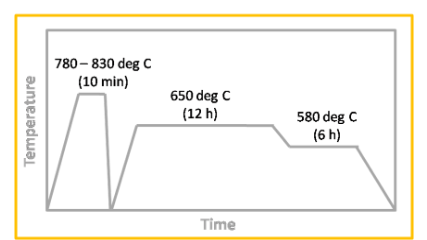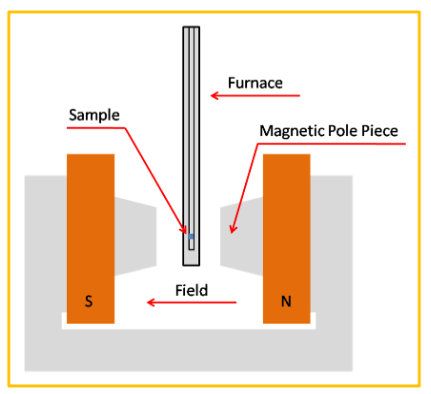ABSTRACT
The promotion of social progress requires greater levels of energy efficiency, quality and productivity. However, these developments usually come at the cost of the environment. Green technologies such as electric vehicles, wind turbine and solar panels are ironically overshadowed by supply limitations and high prices of rare earth elements. Therefore, it is important to find alternative materials to replace those that contain critical elements.
Alnico alloys show high magnetization, high Curie temperature (800°C) and good corrosion resistance, making it one of the best candidates to replace neodymium-based magnets used in electric vehicles.
In this thesis, methods controlling shape an isotropy and grain microstructure were used to improve magnetic properties of Alnico. For shape anisotropy, we studied the effects of isothermal heat treatment (IHT), secondary annealing (SA), and alloy composition.
The magnetic properties of Alnico were found to be highly sensitive to IHT temperature and time rather than SA temperature and time. Since shape anisotropy is driven by microstructure evolution, it is likely that the evolution has mainly been determined by IHT processing.
We found Co increases the spinodal decomposition temperature while it is decreased by Ti. For grain microstructure, we tuned it by controlling wheel speed, and found the optimal magnetic properties were obtained at 20 mps. Textured Alnico was fabricated by setting up a simple casting system. However, a steep temperature gradient was un stable during the casting process due to heat transfer into the atmosphere.
The non-magnetic gamma (gamma) phase is known for its deleterious effect on the magnetic properties of Alnico. Here, alloying additions of Sn and Ge were found to decrease amount of gamma phase. The role of Sn or Ge could be to suppress gamma phase formation or shrink the temperature range over which the gamma phase is stable.
Furthermore, we studied the effect of magnetic field annealing, and found that its effectiveness depends on IHT temperature and alloy composition. For Alnico 9, the maximum coercivity of 1416 Oe can be obtained after full heat treatment.
LITERATURE REVIEW
History of Alnico Alloys:
Alnico permanent magnets were developed in early 1930s by Japanese scientist Tokushichi Mishima. He developed permanent magnet made from nickel, aluminum and iron with better magnetic properties than “magnet steels” available at the time. A few months later, he reported addition of cobalt(Co) could further enhance the magnetic properties of the alloy.
Manufacturing Process:
Commercial Allnico alloys are fabricated by casting and sintering. For cast Alnico, pure elements are put into a furnace and melted at 1750-1780 °C. The molten Alnico alloy is poured into sand molds with required shape of magnet. The sand mold and casting is cooled rapidly to avoid the formation of gamma phase. Sometimes there are chilled plates at the bottom of the molds to aid cooling.
Heat Treatment:
As-made Alnico alloys are magnetically soft, with the coercivity of a few oersted. Their relatively good magnetic properties are given by heat treatment. Therefore, heat treatment study is very important for improving Alnico alloys ‘performance. Heat treatment of Alnico alloys depends on their types. Typically, the heat treatment of Alnico includes three
steps.
EXPERIMENTAL PROCEDURE
Arc Melting:
Arc melting or vacuum arc melting is a traditional method used to prepare solid metal ingots. In our process, pure metals were placed on a water cooled copper plate. The chamber of the arc melter was repeatedly pumped and back filled with high purity argon gas. The base pressure was around 100 mTorr and the operating temperature was slightly below atmospheric pressure. A large voltage was applied to tungsten electrode to generate the arc.
Scanning Electron Microscopy:
Scanning electron microscopy (SEM) is a technique that uses a focused electron beam to scan a sample. Through interaction of the electron beam and the sample, various signals are generated, such as secondary electrons, back-scattered electrons, and characteristic X-rays.
Secondary electrons provide useful information about topography of the sample, while back-scattered electrons show atomic number contrast. The SEM is equipped with energy dispersive X-ray spectroscopy (EDS) to reveal the composition of the sample by using characteristic X-rays.
EFFECT OF HEAT TREATMENT
Isothermal Heat Treatment:
The coercivity of Alnico magnets arises from shape anisotropy, which despends on microstructure, such as the aspect ratio of alpha1 phase, composition of alpha2 phase, and interface microchemistry controlled by alloy composition and heat treatment process. Therefore, we report the effect of alloy composition and annealing on magnetic properties of Alnico in this chapter. The compositions similar to Alnico 8 and 9 were designed due to their potential for high coercivity and energy product.
EFFECT OF GRAIN MICROSTRUCTURE
Wheel Speed:
Magnetic properties of ferromagnetic alloys not only depend on intrinsic properties, but also microstructure, such as grain size, content of main phase, and phase distribution. For example, magnetic properties of neodymium magnets vary with the change of microstructure controlled by fabrication methods.
In general, the coercivity of a neodymium magnet increases as the grain size decreases. This is because that when the rain size is the same order of dimension as that of single domain particle, the domain wall is pinned at the grain boundaries, and a magnetic field higher than the pinning force is required to reverse the single-domain particle, following with higher coercivity.
AVOIDANCE OF GAMMA PHASE BY ALLOYING ADDITION
Gamma phase is a FCC phase, which is detrimental to magnetic properties. gamma phase is stable at temperature range from 860 °Cto 1200 °C. In order to avoid gamma phase, researchers tried to quench Alnico alloys from their homogenized state, which effectively avoids gamma phase transformation.
However, the solutionization requires high temperature furnace. This is not cost-effective for industry production. Furthermore, it is hard to solutionize high Co-containing Alnico alloys without destroying grain microstructures, since the temperature range of gamma phase almost coincides with the solidus of Alnico.
EFFECT OF FIELD ANNEALING
Alpha1 phase spontaneously aligns in crystallographic <100> direction, since it‟s an energy-favorable direction . However, <100> is the family of directions, which means Fe-Co rich phase will align in three directions without applied magnetic field.
In order to obtain an isotropy, a magnetic field is applied so that alpha grows in only one of the three <100>. This will not only improve coercivity, but also remanence and energy product. Therefore, we investigated the effect of magnetic field on magnetic properties of melt-spun Alnico alloys.
CONCLUSION
In conclusion, we tried to improve magnetic properties of Alnico by controlling shape anisotropy and grain microstructure. For shape anisotropy, different alloy compositions and heat treatments were investigated. We found its coercivity is highly sensitive to isothermal heat treatment temperature and time. Co increase spinodal decomposition temperature while it is decreased by Ti. Although secondary and tertiary heat treatments further improve magnetic properties of Alnico while they are not sensitive to heat treatment temperature and time.
It is because shape anisotropy has mainly been developed during isothermal heat treatment. For grain microstructure, we found that magnetic properties of melt-spun Alnico ribbons were controlled by wheel speed. Spinning speed at 20 mps yields optimal magnetic properties. We fabricated textured Alnico by setting up a simple casting system. However, its magnetic properties were not improved . Since a steep temperature gradient is not stable during casting process, resulting in a tilt of columnar crystals.In addition, the deleterious effects of γ phase and S may overshadow the benefit of texture.
We studied the effect of alloying additions on the avoidance of γ phase, and found 0 to 1 wt% Sn effectively suppress the formation of gamma phase. It is likely that Sn is a nα phase stabilizer or tend to decrease the temperature range where gamma phase is stable. Ge has a similar effect. However, both of them have deleterious effects on magnetic properties.It is likely that they will ruin shape anisotropy or form impurity phases in Alnico.
We also examined the effect of field annealing on magnetic properties of Alnico. We found that the presence of magnetic field decreases IHT temperature. It is likely that a magnetic field promotes spinodal decomposition. Therefore, the optimal temperature is decreased.For the melt-spun Alnico 9 sample, the maximum coercivity of 1416 Oe can be obtained after FHT.
Source: University of Nebraska-Lincoln
Author: Li Zhang


